Rod's Keynote Address to SESAPS
April 6, 2015
I was surprised when Dr. Brian Thoms approached me in the spring of 2015 about doing the keynote address at the Southeastern Section of the American Physical Society (SESAPS) that was to meet on the Georgia State University campus. They wanted to hear about the development of HyperPhysics. It turned out that most of the physics teachers who were in attendance had used HyperPhysics, and the suggestion of me as the keynote speaker for the meeting had come from a high school teacher who was doing some graduate work at Georgia State and was very enthusiastic about HyperPhysics. It was an interesting experience to think back on the development of HyperPhysics and come up with items that I thought would interest them. We met in one of the nice classrooms in Classroom South which had a very nice projection system and I developed the talk around a Keynote presentation.
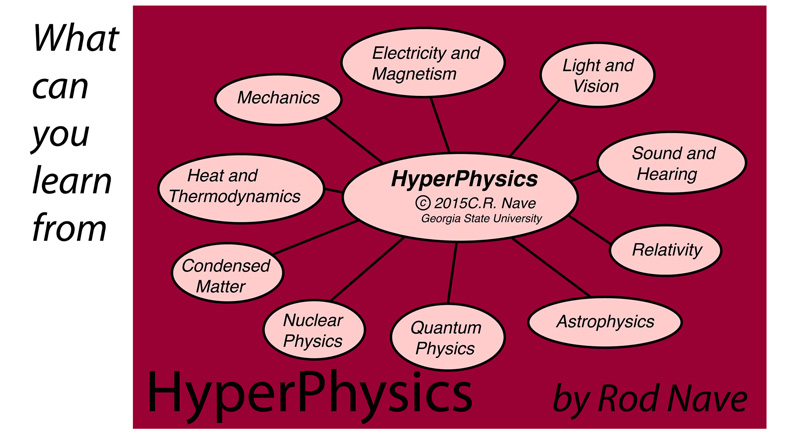
HyperPhysics is now composed of frameworks of information associated with ten areas of physics and astronomy. It makes extensive use of concept maps following the work of Joe Novak in his book "Learning How to Learn". It has been on the web since 1998 following a major changeover to html, the language of the World Wide Web.

The use of HyperPhysics on the web grew rapidly, and was also distributed on CD and then DVD. The map above shows the distribution outside the United States to 82 countries as of 2015.
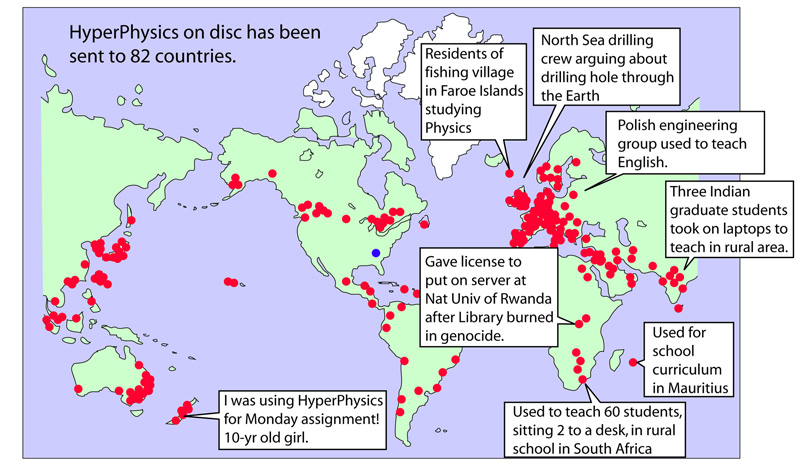
Both the web use and the distribution of DVDs led to some interesting interactions.
- On one Saturday morning I received an email from a 10-yr old girl in New Zealand, fussing at me because she couldn't get on HyperPhysics, and she had been using it for a school assignment that was due on Monday. It was my first notice that HyperPhysics was down this weekend, although Friday night work at the computer center had taken the site down before. So I drove in to Georgia State and rebooted the server computer and put it back online and drove home to email the student in New Zealand that it was operational again.
- After the terrible war and genocide in Rwanda, I received an email from a faculty member at the National University of Rwanda, asking if they could make use of HyperPhysics in their physics teaching. The library of the University had been burned during the warfare, and it was more economical to use computer-based material than to replace the books. So I sent them a copy of HyperPhysics on CD with permission to post it on their local server. For a couple of years, I got a Christmas card from the University, thanking me for the use of HyperPhysics.
- When I got an order for a HyperPhysics DVD from the Faroe Islands, I had to look it up on the map. It turns out to be a tiny group of islands between Europe and Iceland which forms a fishing community. It was an impressive example of the penetrating power of the web when people from this isolated location had been able to use HyperPhysics on the web.
- I got an email from the Captain of a North Sea drilling crew that was drilling oil wells in the North Sea. That deep drilling operation got the crew to arguing about what would happen if you drilled all the way through the Earth. Someone found my discussion of a hole through the Earth in HyperPhysics, so the Captain emailed me to ask some questions about it.
- I had sent several DVD copies of HyperPhysics to Poland, and of course they could access it on the web. I was interested to hear from an engineer there that they had a group of engineers that was gathering to study HyperPhysics with the goal of learning English from it in a context of material which which they were familiar.
- I got an email from three physics graduate students in India who were interested in taking their laptop computers out into the countryside for teaching physics there. I sent HyperPhysics on DVD to them with permission to put it on their laptops for their teaching mission.
- I was surprised to receive an order for a HyperPhysics DVD from a teacher on the island of Mauritius, which I found on a map eastward from Madagascar in the Indian Ocean.
- I received an order for a HyperPhysics DVD from a retired engineer who was teaching science at a rural school close to Durban, South Africa. He wrote later to tell me that he hadn't received it and that theft of mail was a serious problem there. He provided me with a more secure way to send a package so I sent a second copy. He wrote back to tell me that he was using it to teach a class of 60 students, sitting two to a desk! He told me that the area was about 15 miles from the ocean at Durban, but that none of his students had ever seen the ocean.
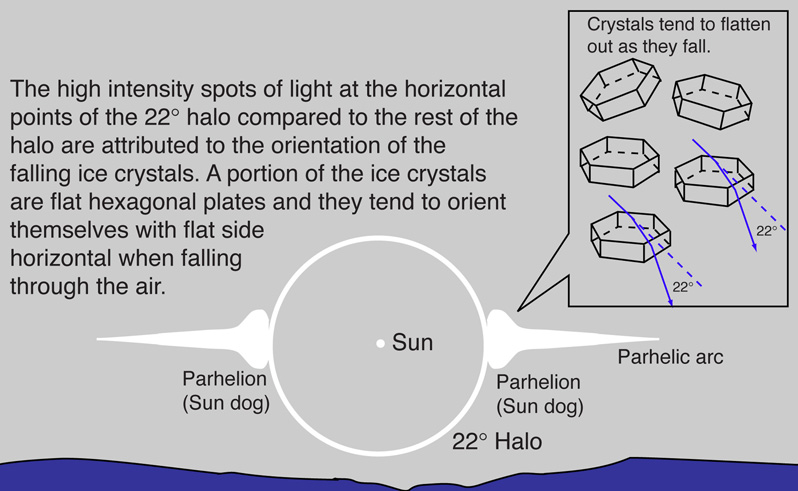
As an example of a subject discussed in HyperPhysics and the interactions it led to, I described the phenomenon of sundogs, the bright spots with rainbow colors on each side of the Sun which appear sometimes in cold weather. The descriptive term for these two spots, formally titled parhelia, is attributed to their viewing in Eskimo areas where they described them as the Sun's dogs. Having seen beautiful examples of sundogs in the books and slide demonstrtions of Robert Greenler, I had entered into a good natured debate with him (a Wisconsin resident) about whether I could see them in Atlanta. I argued that I couldn't see them, because if it was cold enough with water in the upper atmosphere to form ice, it would also form clouds that would obscure them.
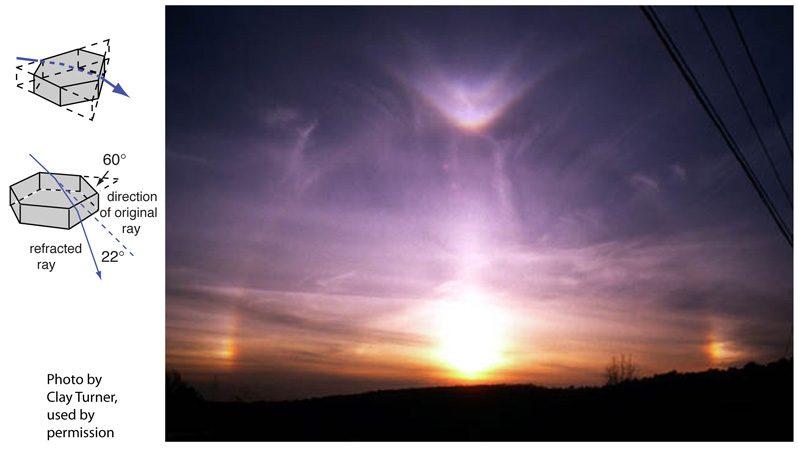
I was dramatically proven wrong when Clay Turner, one of the students that I had taught in our optics course, brought me this picture which he had taken in north Atlanta. I conceded the loss of the argument and asked Clay for permission to post his picture in HyperPhysics.

The next event in this process was that I received mail from Dr. Richard Sadleir, a naturalist in New Zealand, who had photographed dramatic sundogs in Antarctica when he was there counting penguins! The preponderance of my examples of sundogs were from very cold climates. But then came the ultimate rebuttal to my reluctance to believe that sundogs would be seen in warm climates. I got the picture of the 22° halo with sundogs from Frank Starmer, who had a teaching position at a medical school in Singapore. On a vacation cruise, he had photographed the sundogs upper left above within one or two degrees of the equator. So ice crystal phenomena in the upper atmosphere can be seen even at the equator!
The observation about HyperPhysics here is that the free sharing of information on the web can penetrate to all parts of the globe and lead to interesting shared learning experiences.
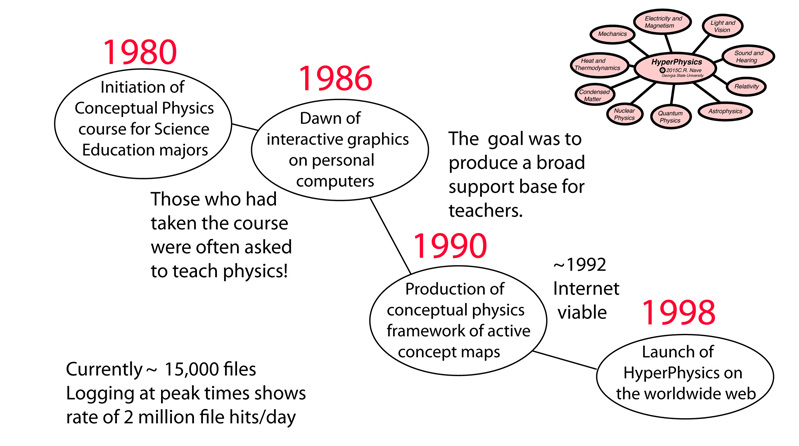
This concept map about the development of HyperPhysics notes that I had initiated the Conceptual Physics course at Georgia State in 1980 and had sent out about 25 teachers each year into the schools. By 1986 I was using computers in instruction and beginning to dream about producing a computer-based exploration environment to help teachers in the field, particularly since a number of them had been asked to teach physics. By 1990 I had the tools to begin building a framework based on concept maps and using the HyperCard environment to include navigation and calculation features. Numerous problems with the HyperCard environment led to the switch to html, the language of the web, and the first html version of HyperPhysics was placed on the web in 1998. The World Wide Web had become a reality in that time frame, about 1992.

With the idea that persons in the room to whom I was speaking would themselves be likely to contribute advances in educational strategy, I addressed some of the pitfalls and the mistakes I had made along the way. In the first place, I was putting massive effort into a proprietary framework, the survival of which was uncertain and beyond my control. The HyperCard framework did in fact disappear. This helped me see the vulnerability of building a massive instructional initiative upon a proprietary framework which might disappear. I also used low resolution video material because of the large memory requirements of that time period rather than anticipate that the technology was bound to improve. Finally, I was developing matierial that was not cross-platform.
A major discussion at the 1997 Denver AAPT meeting put me on the track of developing in html, the language of the web, which we characterized as the "clearing in the forest". It was a cross-platform develpment environment that would not likely go away because it had been settled upon as the language of the world wide web.
That launched me on an intensive effort to port the development that I had made in HyperCard over to html with the promise of being able to put it on the web.
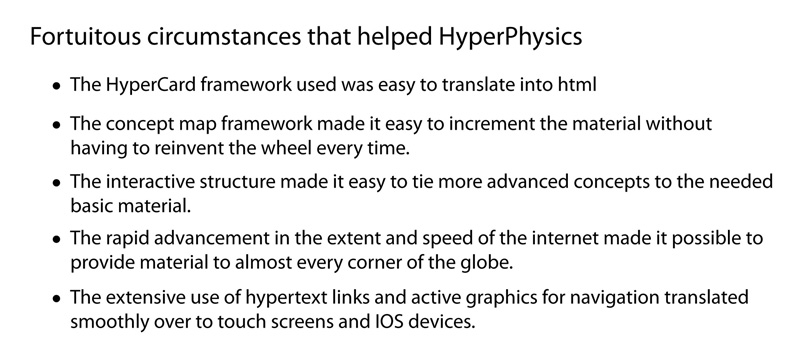
Despite the mistakes and the misdirections, there were also circumstances that remarkably worked to help with the development of HyperPhysics.

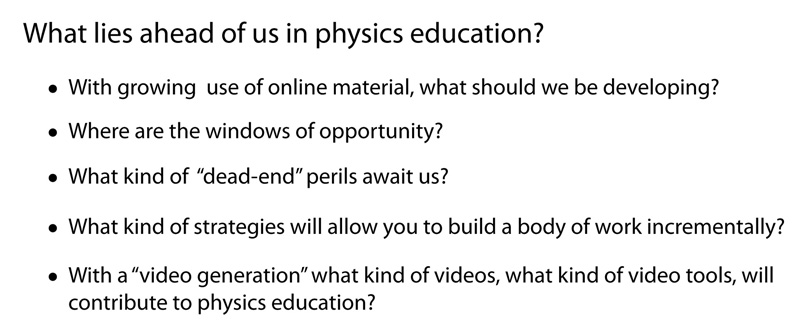
| Back to Bent Tree and then Hiwassee |
2015